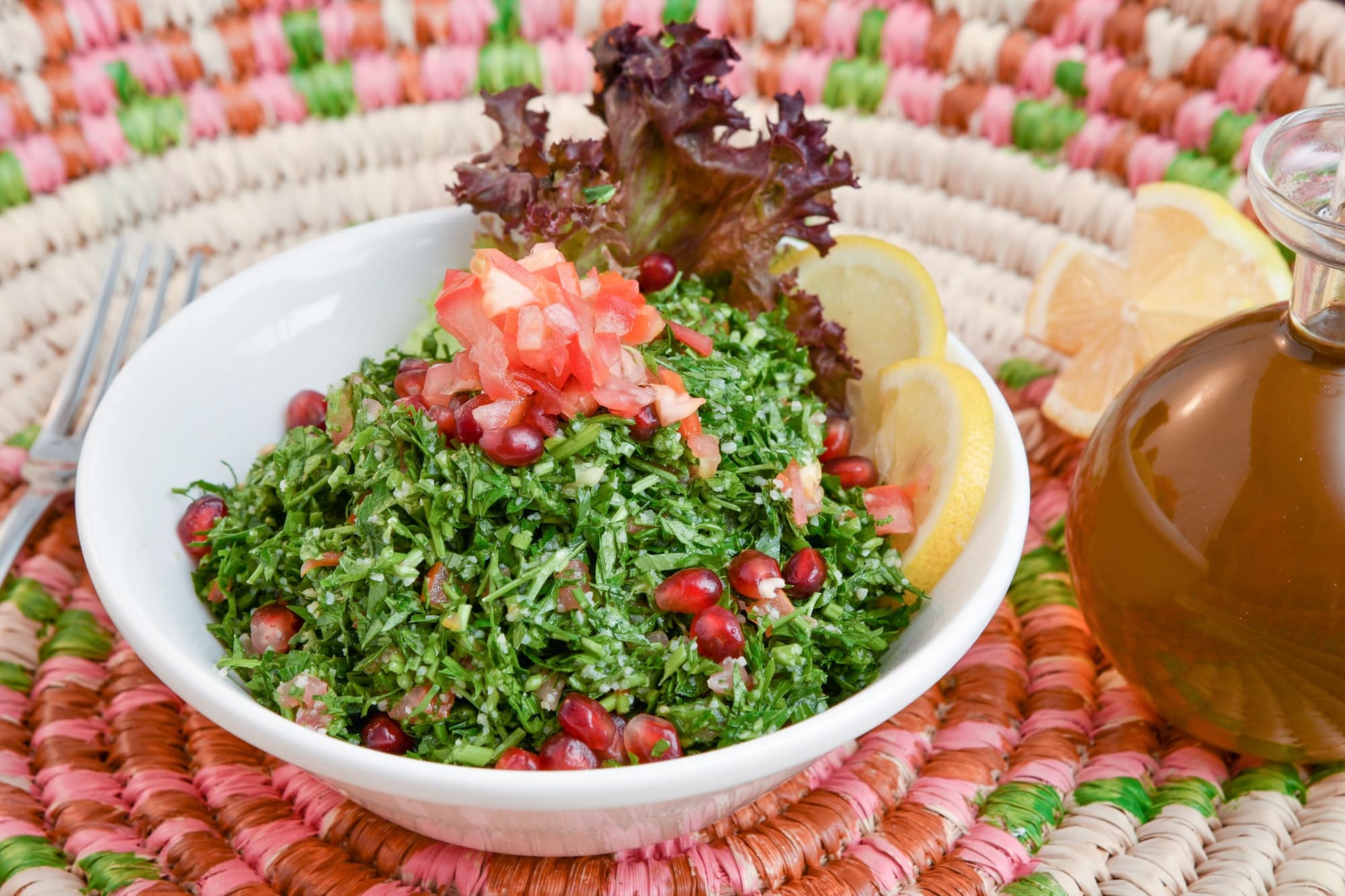It’s a bright and sunny afternoon, and you’re thinking about what to prepare for lunch. You desire something light, yet flavorful, a dish that’s easy and quick to whip up, but also bursting with invigorating freshness. Enter the Lebanese Tabbouleh – a Middle Eastern salad that ticks all the boxes. This paradigm of freshness is not just another salad. It is a refreshing, zesty, and texture-rich symphony of bulgur wheat, parsley, tomatoes, and an assortment of other ingredients that will transport you to the heart of Beirut with every bite. Let’s dive into the world of tabbouleh and discover how to create this vibrant salad at home.
The Quintessential Components of Lebanese Tabbouleh
Every dish has its soul, and the soul of the Lebanese Tabbouleh lies in its ingredients. The salad is a harmonious blend of healthy, fresh components each contributing to the overall flavor profile. The prime ingredients that mark the identity of tabbouleh are parsley, bulgur, tomatoes, green onions, fresh mint, and lemon.
A lire aussi : What’s the Best Way to Prepare a Gourmet Spinach and Gorgonzola Pizza?
Parsley, the green star of this dish, provides a tangy, slightly bitter flavor that balances the sweetness of the tomatoes. The bulgur, a type of whole wheat grain, offers a pleasant chewy texture. Tomatoes infuse the salad with juicy sweetness, while the green onions add a mild, yet noticeable, pungent kick. Fresh mint leaves deliver an unexpected yet delightful coolness, and lemon juice lends a zesty tang to the mix.
Understanding each ingredient’s unique characteristics will enable you to balance their flavors and create a tabbouleh that’s truly exceptional.
A voir aussi : What Techniques Ensure a Perfectly Baked Brioche with a Golden Crust?
The Art of Crafting the Perfect Tabbouleh
Creating a Lebanese Tabbouleh might appear straightforward, but it is an art in itself. It demands careful attention to detail, from the selection of ingredients to their preparation and assembly.
Begin by choosing the freshest ingredients. Look for bright green parsley leaves, firm ripe tomatoes, and aromatic fresh mint. For bulgur, opt for the fine variety as it absorbs flavors well and offers the right texture.
Start preparing the salad by soaking the bulgur. Add about a quarter cup of bulgur to half a cup of boiling water. Cover it and let it sit for about 20 to 30 minutes, or until it’s soft and chewy.
While the bulgur is soaking, you can begin chopping your vegetables. Finely chop the parsley, tomatoes, and green onions. Make sure to remove the stems from the parsley and only use the leaves. Discard the seeds from the tomatoes to avoid a watery salad.
Next, prepare the dressing. In a separate bowl, squeeze the juice of two lemons. Add about one-third of a cup of extra virgin olive oil, salt to taste, and a pinch of black pepper. Whisk them together until well combined.
By now, your bulgur should be ready. Fluff it with a fork to separate the grains and allow it to cool. When cool, transfer it to a large bowl and add in the chopped vegetables. Finally, pour over the lemony dressing, toss well, and let the salad rest for a few minutes before serving.
The Role of Fresh Mint and Lemon in Enhancing Tabbouleh
Fresh mint and lemon are two key ingredients that give Lebanese Tabbouleh its distinctive character. They play crucial roles in enhancing the salad’s overall flavor and bringing a refreshing twist to the dish.
Fresh mint imparts a cool, refreshing flavor that compliments the tanginess of the lemon and the earthiness of the bulgur. This herb also provides a beautiful contrast against the bright green parsley and red tomatoes, making the salad visually appetizing.
Lemon, on the other hand, adds a zesty tang to the dish. Its sharpness cuts through the richness of the olive oil in the dressing, balancing the flavors. The lemon juice also helps keep the salad fresh, preventing it from oxidizing and losing its vibrant colors.
Adding fresh mint and lemon to your tabbouleh will truly elevate the dish, making it a culinary masterpiece.
Crafting a Vegetarian and Gluten-Free Tabbouleh
The Lebanese Tabbouleh is inherently vegetarian, made with fresh veggies and herbs. But if you’re looking for a gluten-free version, you can easily modify the traditional recipe.
The key is to find a suitable substitute for bulgur, which contains gluten. Quinoa is a fantastic option. It’s a protein-rich seed that’s naturally gluten-free and has a similar texture to bulgur. Another alternative is cauliflower rice, which you can easily make by pulsing raw cauliflower florets in a food processor until they resemble grains.
To make a gluten-free tabbouleh, simply replace the bulgur with your chosen substitute and follow the same steps as in the original recipe. The result will be a nutritious, flavor-packed salad that’s suitable for everyone at your table, regardless of dietary restrictions.
In the end, the beauty of Lebanese Tabbouleh lies in its simplicity and versatility. It’s more than just a salad. It’s a celebration of fresh, vibrant ingredients that come together to create a dish that’s both healthy and delicious. So, dive into the art of crafting a Lebanese Tabbouleh, and let this beautiful salad bring a burst of Mediterranean flavors to your everyday meals.
Pairing Lebanese Tabbouleh with Other Dishes
The beauty of the Lebanese Tabbouleh salad, apart from its vibrant colors and flavors, lies in its versatility. It seamlessly fits into a wide array of culinary contexts, thereby elevating the taste of various dishes. It could be used as a main dish, a side dish, or even a light and healthy meal on its own.
When served as a main dish, Tabbouleh salad becomes the star of the table. Prepare it with fresh mint leaves, finely chopped parsley, tomatoes, green onion, and fine bulgur wheat, delicately dressed with a blend of lemon juice and extra virgin olive oil. This Middle Eastern wonder can stand alone as a light, yet fulfilling meal.
If you’re planning a more extensive spread, Tabbouleh also makes a fantastic side dish. Consider pairing it with grilled meats or fish. The freshness and zest of the tabbouleh salad balance the smoky, rich flavors of the grilled items beautifully. Tabbouleh also pairs well with fried falafel or stuffed grape leaves, offering a refreshing contrast to the heavier dishes.
For a vegetarian feast, you can pair the Tabbouleh with hummus, baba ghanoush, and pita bread. This salad recipe, bursting with freshness and tangy flavors, perfectly complements the creaminess of the hummus and baba ghanoush.
Remember, the key to a great Tabbouleh is to keep it fresh. Prepare it close to serving time, so it retains its vibrant colors and crisp textures.
Conclusion: The Joy of Crafting a Lebanese Tabbouleh
Crafting a Lebanese Tabbouleh is not just about following a salad recipe. It’s about embracing a culinary ritual that brings together vibrant ingredients to create a dish that’s as visually appealing as it is deliciously satisfying.
From selecting the freshest parsley, mint, green onions, and tomatoes, to soaking the fine bulgur wheat just right, every step matters. The blend of extra virgin olive oil and lemon juice brings together the various components into a harmonious mix, making every bite a delightful experience.
Whether you’re preparing the traditional version or the gluten-free variant, remember it’s the quality of the ingredients and the love you pour into the preparation that truly makes a Lebanese Tabbouleh. Let the tabbouleh recipe be a guide, but don’t hesitate to tweak it to suit your preferences.
In the end, a Lebanese Tabbouleh is not just a salad. It’s a celebration of fresh flavors, a journey into the heart of Middle Eastern cuisine, and a testament to the joy of crafting a meal that’s as healthy as it is delicious. So go ahead, dive into the art of creating a Lebanese Tabbouleh, and let this dish bring a touch of Beirut to your kitchen.











